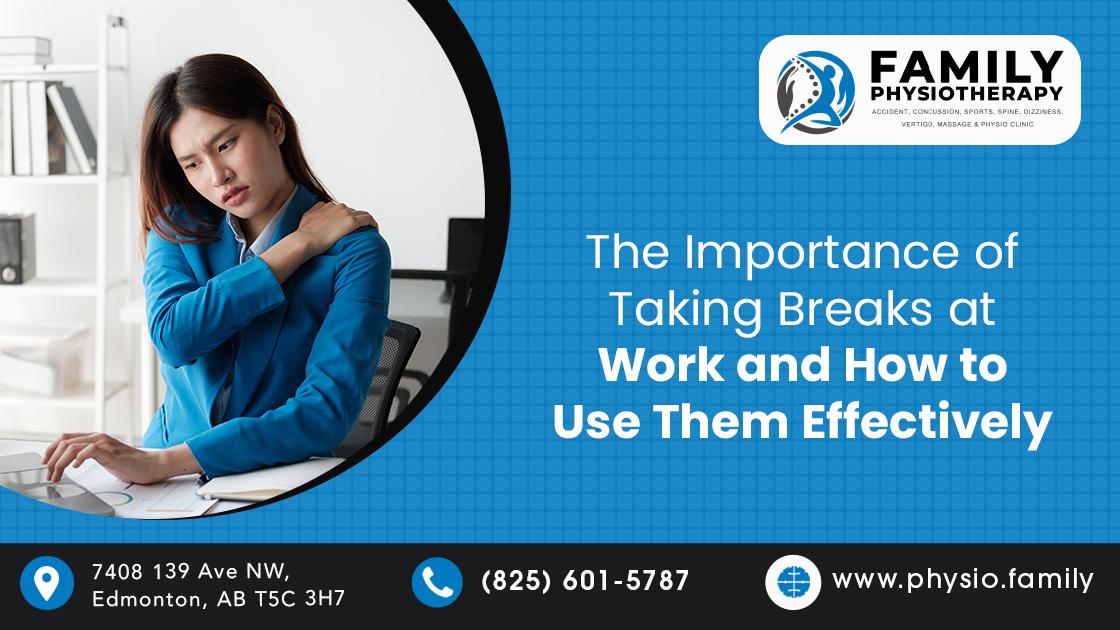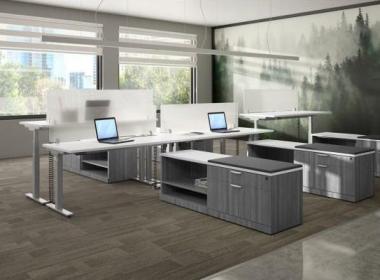
In today's fast-paced work environment, many employees feel pressured to stay glued to their desks. While long hours of uninterrupted work might seem productive, neglecting to take regular breaks can lead to physical and mental burnout, reduced efficiency, and even injuries. Work injury physiotherapy in Edmonton emphasizes the importance of preventive measures, like taking well-timed breaks, to protect workers from strain and repetitive stress injuries.
Why Taking Breaks at Work Matters?
Taking breaks during the workday is about more than simply stepping away from tasks. Research has shown that breaks play a vital role in reducing stress, boosting creativity, and improving focus. Physical activity during breaks can also contribute significantly to work injury prevention, as it helps relieve muscle tension and counteracts the effects of prolonged sitting.
Prolonged periods of sitting have been connected to issues such as back discomfort, neck strain, and even cardiovascular problems. Engaging in brief, consistent breaks helps mitigate these risks, allowing employees to reset both mentally and physically. In fact, many experts in workplace wellness recommend frequent breaks throughout the day to improve productivity and reduce the likelihood of developing chronic discomfort conditions.
How Do Breaks Help Prevent Work Injuries?
For those who spend hours at a desk, repetitive strain injuries and musculoskeletal discomfort are common risks. Sitting for long periods without movement puts pressure on the spine, hips, and lower back, which can lead to stiffness and pain. Over time, this lack of movement may contribute to more severe conditions than work injury physiotherapy.
Regular breaks give the body a chance to shift posture, stretch tight muscles, and promote blood flow. Simple desk exercises and break-time stretches help loosen up areas that tend to become tense, such as the neck, shoulders, and lower back. Incorporating these practices as part of a daily routine is a proactive approach to workplace wellness and an effective way to reduce the likelihood of workplace injuries.
Effective Ways to Use Breaks for Physical and Mental Wellness
To make the most of each break, employees can incorporate specific activities that focus on both mental refreshment and physical relaxation. Work injury physiotherapy in Edmonton provides guidance on these practices to help prevent strain and promote overall wellness. Here are some practical ways to use breaks effectively for better well-being:
1. Desk Exercises for Flexibility and Strength
Desk exercises are easy-to-do movements that require minimal space and no equipment. They're ideal for keeping muscles active and promoting good posture throughout the day. Examples include seated leg raises, shoulder shrugs, and neck rolls. These exercises improve blood circulation and prevent stiffness, making them essential for work injury prevention.
Seated Leg Raises: Sitting up straight, slowly lift one leg at a time, hold for a few seconds, then lower. This helps activate the quadriceps and core.
Shoulder Shrugs: Raise both shoulders toward the ears, hold for a moment, then release. This movement helps relieve tension in the neck and shoulders.
Neck Rolls: Gently roll the neck in a circular motion to release tightness and reduce stress in the upper spine.
2. Break-Time Stretches for Better Mobility
Break-time stretches are an excellent way to counteract the stiffness that develops from prolonged sitting. Stretching helps lengthen tight muscles and enhance joint mobility, minimizing the risk of repetitive strain injuries. Incorporating a few minutes of stretching during breaks can make a noticeable difference in posture and comfort.
Hamstring Stretch: Stand up and position one foot on a low surface, like a chair or stool. Lean forward gently to stretch the back of the thigh. This stretch reduces tightness in the legs and lower back.
Chest Opener Stretch: Clasp hands behind the back, straighten the arms and gently lift them to open up the chest. This stretch counteracts the hunching posture often associated with desk work.
Wrist Stretch: Stretch one arm in front with the palm facing up, and use the other hand to gently pull the fingers back. This helps relieve tension in the wrists, especially for those who type frequently.
3. Mindfulness and Breathing Exercises for Mental Clarity
In addition to physical exercises, breaks are an ideal time for mindfulness practices that enhance focus and reduce stress. Spending a few moments to practice deep breathing or short meditation can help clear the mind and improve mental performance.
Deep Breathing: Sit comfortably, close your eyes, and breathe slowly and deeply, paying attention to the sensation of each breath. This helps reduce stress and provides a mental reset.
Guided Meditation Apps: Using a meditation app for a five-minute session can promote relaxation and improve concentration. Apps like Headspace and Calm offer quick, easy-to-follow exercises that are perfect for workplace wellness.
Setting a Routine for Regular Breaks
Creating a routine for taking breaks can make a significant difference in workplace wellness. Many experts recommend following the "Pomodoro Technique," which entails working for 25 minutes followed by taking a five-minute break. After four cycles, a longer 15–30 minute break is recommended. This method not only keeps the mind fresh but also encourages movement and prevents prolonged sitting.
Employers can also support break-taking habits by setting up designated areas for relaxation or even encouraging group stretch sessions. When everyone prioritizes break time, it helps build a culture of wellness and productivity in the work area.
Prioritizing Breaks for Workplace Wellness
Incorporating regular breaks, desk exercises, and break-time stretches into the workday is essential for preventing injuries and maintaining physical and mental well-being. For those experiencing discomfort or early signs of strain, seeking guidance through work injury physiotherapy in Edmonton can be an effective solution. Family Physiotherapy in Edmonton provides specialized care to help individuals recover from workplace injuries and develop preventive strategies. Prioritizing breaks and engaging in workplace wellness practices ultimately fosters a healthier, more productive work experience.
Read More.. 21 Best Alternatives of Manga Stream to read manga Instantly Best Crazy Games For Childrens How to make selfies with dorian rossini What Happened to Konami The 13 best things to do in the ICELAND 6 Things to Know About Wrongful Death Suits How to increase your customer numbers How to Manipulate Online Slots Know Lab Made Loose Diamonds in Easy Steps 5 Best Winter Fashion Style Tips 5 Best Work From Home tips You should know The 5 Best Budget Friendly Hair Dryers 5 Best Fruit for Babies Diet Methods of Freight Rate Quotes Advantages of Road Freight Understanding Search Engine Optimization in the Competitive Marketplace Tips to Winning Big in Online Casino GPHR Certification Make Your Target Challenges Facing Shippers Transport Top 5 Methods for Online Slots 10 Daily Habits to Keep a House Clean and Tidy Calgary Window Reviews Lux Windows versus Jeld Wen Windows and Doors The Black 411 Announces Plans An Ultimate Guide for CompTIA SK0-005 Exam by Exams4sure List of Few Best Gaming APIs Like Escape from Tarkov, Fortnite API and More How to Get a Used ATV or UTV on the Economical Buying guide for Lighting Reasons Why Regular Website Maintenance Is Important Tips to make your Beauty Beds Last Longer 123Movies Watch Movies Free Online Where to birthday cake order in kohara Finding the Best Freight Shipping Quotes Top 10 Nursing Trends That Will Shape Healthcare Basic Safety Measures For Athletes’ Protection Repair Or Replacement What Does Your Tyre Need VoIP headsets Heads Free Head Set Zone Trending App Ideas for Beginners 8 Reasons to Maintain Up to Date Bookkeeping The best international high schools in Tokyo Japan On Site Rigging Services For The Transportation Industry 5 Ways to Improve Team Communication and Collaboration Why Should You Hire Professional Roofing Contractors in Daytona Beach How To Live A Balanced Lifestyle With Work In Canada Tips to enhance your IGTV Videos Best Furniture For Home in Dubai
Also read about:
Best Business Contract Lawyer
The Best Furniture Sales In Dubai
What Are the Top Trends Mattresses in UAE








